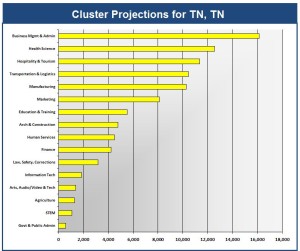Career Pathways Supply and Demand
The following links provide a regional articulation of regional career pathways and supply and demand information based on the the Onet Job Zones of 2, 3, 4 and 5.
Career Pathways – This link provides a formal articulation of Career Pathways in relationship to the 16 United States Department of Education career clusters with career pathways definitions, related occupations for each career pathway with average wages, job zones, ACT NCRC skill levels and projected long term demand.
Occupation Demand Spreadsheet – Provides listing of occupations sorted based on projected demand with job zones, ACT NCRC levels, average wages and career cluster and pathways.
Occupation Lookup – Provides a lookup of occupations by alphabetical order while providing projected openings, career clusters and pathways, job zone, average wages and ACT NCRC levels
Job Zone 2 Supply and Demand – This link documents incoming supply for job zone 2 career pathways for those learners that have a high school diploma and/or a post secondary award of less than 2 years in relationship to long term projected demand. Projected demand then subtracts incoming supply to arrive at a a projected net demand figure for a given job zone. A positive net demand figure suggests projected under supply while a negative result points to potential regional career
pathways over supply.
Job Zone 3 Supply and Demand – This link documents incoming supply for job zone 3 career pathways for those learners that have a post secondary award of at least 2 years and less than 4 years in relationship to long term projected demand. Incoming supply is subtracted from long term projected demand to arrive at a a projected net demand figure for a given job zone. A positive net demand figure suggests projected under supply while a negative result points to potential regional career pathways over supply.
Job Zone 4 Supply and Demand – This link documents incoming supply for job zone 4 career pathways for those learners that have a post secondary award of at least 4 years and less than 6 years in relationship to long term projected demand. Incoming supply is subtracted from long term projected demand to arrive at a a projected net demand figure for a given job zone. A positive net demand figure suggests projected under supply while a negative result points to potential regional career pathways over supply.
Job Zone 5 Supply and Demand – This link documents incoming supply for job zone 5 career pathways for those learners that have a post secondary award of at least 6 years in relationship to long term projected demand. Incoming supply is subtracted from long term projected demand to arrive at a a projected net demand figure for a given job zone. A positive net demand figure suggests projected under supply while a negative result points to potential regional career pathways over supply.
